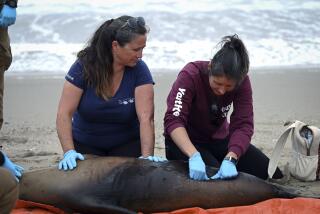California brown pelicans found frail and far from home
Wildlife rescuers from San Diego to San Francisco suddenly are facing a distressing biological mystery: Disoriented and bruised California brown pelicans are landing on highways and airport runways and in farm fields, alleys and backyards miles from their normal coastal haunts.
In the last week, the big brown birds known for flying in formation over beaches have been reported wobbling across Culver Boulevard in Playa del Rey and on a Los Angeles International Airport runway. Two dead pelicans were found on the 110 Freeway. Elsewhere, one smacked into a car.
“We’re a little freaked out by this,” said Rebecca Dmytryk, spokeswoman for the nonprofit WildRescue. “We’ve never seen anything like it.”
On Monday, the International Bird Rescue Research Center in San Pedro and other animal rehabilitation centers continued to receive pelicans of all ages found dead or dying in what Dmytryk described as “the oddest of places.” Many of them shared symptoms including disorientation, extreme fatigue and bruises inside their pouches.
Bird rescuers were rushing pelican blood samples and carcasses to state wildlife authorities and laboratories that specialize in detecting potentially fatal algae toxins, such as domoic acid, that have plagued the species in past years. But domoic acid typically sickens marine animals in spring and summer, not in January.
“We just became aware of this problem a few days ago,” said David Caron, a professor of biological sciences at USC who was analyzing pelican blood samples sent to him from throughout the state. “By the end of the week, we’ll have information that should tell us whether or not these animals test positive for phytoplankton toxins.”
At a cost of about $500 to $1,000 per bird, veterinarians and volunteers were tending to growing numbers of feathered patients with intravenous fluids, medications, warm enclosures and a steady diet of smelt and squid. Sick birds started arriving last month and many of them rebounded within a matter of weeks.
“Pelicans have been hammered over the years by oil spills, DDT, domoic acid, fishing line, gunshots, starvation and parasites -- we’re expert at dealing with those problems,” said David Weeshoff, a volunteer at the San Pedro center. “But right now, we’re scratching our heads over the cause of this event. Not a good deal.”
Unlike previous mass bouts of illness, such as one involving domoic acid that devastated mostly young pelicans last summer, the current problem involves a significant number of adult birds, like the one found dead Sunday in the backyard of Dru Hammond’s home in the foothills near Carmel Valley Village, in Monterey County.
“We’ve lived in this house 12 years and we’ve never seen a pelican here before,” she said. “My husband found it by our small pond. It looked like it just laid down and died there.”
Pending completion of blood and tissue analysis, speculation on possible causes of the event has become a main topic of conversation among animal rehabilitation workers.
Some wondered whether pelicans afflicted by domoic acid in years past had developed a lower tolerance.
Others suggested that the birds had somehow ingested fire retardants and chemical residues washed to sea after recent devastating fires, or caught a virus.
“We’ve ruled out starvation because there are plenty of fish in coastal waters right now,” said Jay Holcomb, executive director of the Northern California-based International Bird Rescue Research Center. “We’re seeking answers from all the experts we can find.”
Brown pelicans plunged to near zero population growth in the 1960s and ‘70s because the pesticide DDT infiltrated their food in nesting grounds such as Anacapa Island, about 11 miles off Oxnard. DDT residues in fish the pelicans consumed were believed to have prevented the mothers from depositing calcium in the shells of their eggs, which caused them to break easily.
When DDT was banned in the United States in 1972, the species started to recover. In February, the Interior Department announced a proposal to remove brown pelicans from the national endangered species list.
More than 70,000 breeding pairs of pelicans inhabit California and Baja California, and total numbers have surged to about 620,000 birds along the West Coast, Gulf Coast and Latin and South America.
“They’re pretty tough, having survived everything they’ve been through,” said veterinarian Erica Lander of the San Pedro rescue center. “But pelicans are also very fragile, and they need our help.”
For more information on helping the birds, visit www.ibrrc.org.
--
More to Read
Sign up for Essential California
The most important California stories and recommendations in your inbox every morning.
You may occasionally receive promotional content from the Los Angeles Times.











